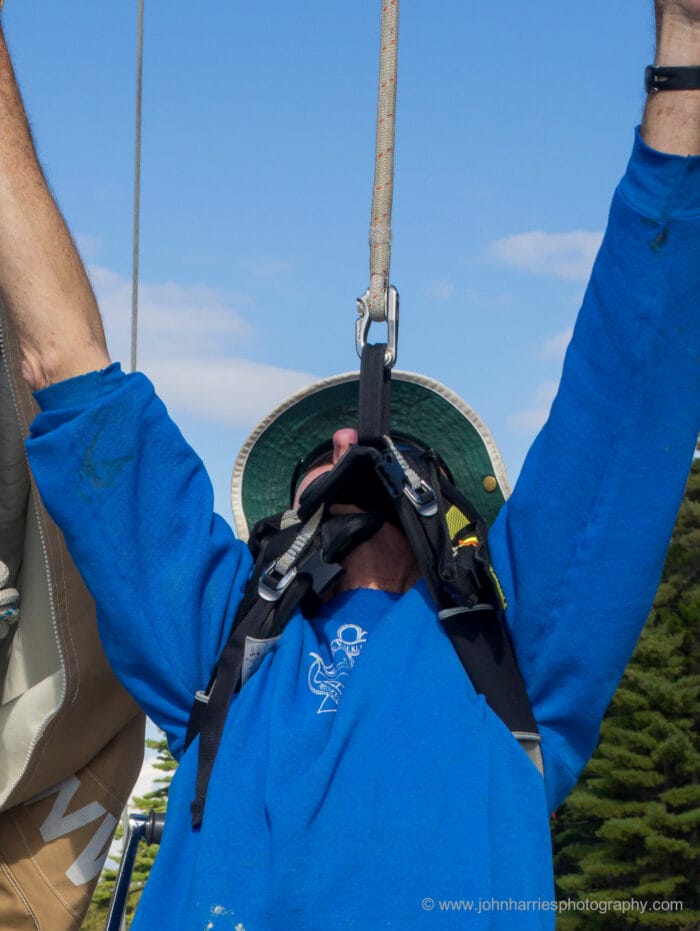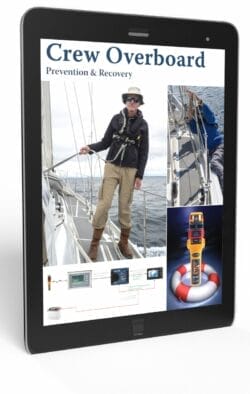
This Tip was originally part of a larger article that we just deleted because it’s out of date—we do that a lot—but this part is still valid and important.
When using a lifejacket as a safety harness, it is vital that the chest strap(s) be tightened enough, every time we put it on, so that we can’t slip out, without relying on the crotch strap, even if we always wear one.
The reason is that crotch straps are not designed to withstand tether arrest loads.
Crotch straps are only designed and tested to withstand the load from jumping from 10 feet into the water while untethered.

One look at any life jacket crotch strap, particularly if we compare it to a real industrial fall arrest harness, will prove the point.
That said, I also confirmed with Spinlock that the crotch straps on the Deckvests are not designed or intended to withstand fall arrest.
Testing
We took the photo at the beginning of the Tip while testing to confirm that I would not slip out of a Spinlock Deckvest when suspended by the tether attachment and with my arms over my head.
Tighten those chest straps…every time.
And I don’t wish to discuss what I had to promise Phyllis before she would let me down.
Further Reading
- Why using a climbing harness is not a good idea either
- Much more on Crew Overboard Prevention:


Hi John,
When a life jacket is inflated, if too tightly fitted, the bladder presses against the chest and can make normal breathing difficult. Coastguard here in NZ recommend wearers be able to fit their fist comfortably between the front jacket buckle and their chest (brother is a Coastguard skipper).
I must do some testing on our life jackets to see what is the best compromise. We currently run two crotch straps on each jacket – we can buy them as spares in the chandlery, but this is still a delusion of safety. The plastic quick release clips on these straps are an obvious weak point, but they are convenient (which thus encourages their use), and helpful when needing a comfort stop in a hurry and a seaway.
A typical dilemma we sailors face…thanks for highlighting it again.
Hi Rob,
Good point on the other side of the coin. I had not thought of that, so thanks for bringing it up. That said I’m reasonably sure the way we have our jackets would pass the fist test, but I will certainly check.
Hi John and others, especially Drew if reading this,
Thinking on how to make our lifejacket crotch straps effective for tether arrest situations, as commented previously.
Firstly, the existing straps needed the plastic loop that attached the shoulder straps at the back to the waist belt replaced (see link pic). Already done, with a simple soft shackle. The shackle’s diamond knot doesn’t seem to be overly noticeable if I lean back against a bulkhead, so no real difference in comfort.
Next, my idea is to have a soft shackle at the front of each crotch strap where it attached to the waist strap, to replace the current Fastex style plastic buckles. These will be almost as quick to attach, as quick to release and won’t come undone in a tether arrest. I’m pretty sure of this since we used a soft shackle to attach the continuous jib sheets on our small Elliott 5.9 race boat and these would be flogged like mad when luffing on the start line in 25 knots and I never had one release in 10 years hard racing (we used this so we could change between the heavy and light air jib quickly between windward / leeward styled fast action races).
Then each crotch strap terminating loop will need to have a longer overlap and be oversewn by hand to equal the tether strength and build.
The waist strap itself already has a sturdy loop for tether attachment and overlapping stainless buckles to secure at the waist. I can’t attach a pic to a tip – so here’s a link to a later model of our lifejackets from Baltic. Ours have an extra crotch strap, so one each side.
The back of the crotch straps will retain their buckles for length adjustment, but these will need to be changed from plastic to stainless ones, which I think we can buy at our local chandlery.
Before I complete and test the prototype (1/2 metre vertical arrest), any improvements or critique of this simplistic approach would be much appreciated.
Rob
Hi Rob,
Interesting project. I look forward to hearing how it comes out. One thought, I hope you will be using a dummy for the test!
Good point John,
Planning on using a live test dummy -> son who enjoys indoor rock climbing, so experienced with falls and harness work…! Intend to use a small set of plastic steps we have for boarding from a dock, start from the deck, progressing to the top step at about 450mm. And use the topping lift which is double-braid polyester and should provide some reasonable stretch in the system.
What about a flotation jacket coupled with a fall arrest chest harness like a Petzl Newton?
Hi Brian,
That would certainly work for fall arrest, but I can’t imagine getting in and out of it for every watch, and every time I needed to adjust my clothing. I have written here about how important ease of getting in and out of safety gear is:https://www.morganscloud.com/2013/04/11/staying-aboardpart-6-harnesses/
Not to be cynical (yes, I am), but nothing will change in the body-wight-only leg loops until a few people die. We’ve seen this with tethers, PFDs, and sailing carabiners. For some reason, sailing is different than other sports and industry.
You can, of course, make your own stronger leg loops. They could be simple, just using something sturdier than Fastex buckles, and they would be pretty good. Of course, unless thoughtfully designed they can crush your junk and slide down behind your knees when sitting, tripping you when you stand up.
I made a very simple set that could be added to any harness, that fit far more comfortably than any climbing sort, and I even drop tested them 5 times (6 feet) with me as the test dummy and my wife taking pictures. No sting, no problem. They could easily double for work up the mast, they are that strong and secure. They were designed to be one-size-fits-all, adjusting from loose and comfortable to snug in the right places as the load comes on.
But no market.
Hi Drew,
Yes, I read you article at PC about that good idea. Feel free tbo link to it, and you can also add a photo to your comment.
One question for you: What’s the effect on speed of donning? Always something I worry about on an offshore boat because it’s so important to be able to get on deck in a hurry and that can be an issue if asleep in a bunk: https://www.morganscloud.com/2013/04/11/staying-aboardpart-6-harnesses/
a. Yup, adds a few moments. Any leg loop would.
b. It can be fitted so that they are comfortable enough to mostly leave on. That was the focus of the project. No crushing your junk if you move wrong. Made from lightweight 1″ webbing, and self-adjusting when you twist and move.
I find that I can’t wear the normal sort of leg loops. They are constantly shifting into positions that pinch, bind, or trip me.
Also, a problem with the sort that Matt is wearing is that they are for falls, not suspension. The leg loops press outwards on the inner thigh, compressing the femoral arteries. You really can hang for more than 5 minutes before your legs fall dangerously asleep. If you are going to use a harness up the mast, it must be a back-of-the-leg design, like climbing and arborist harnesses.